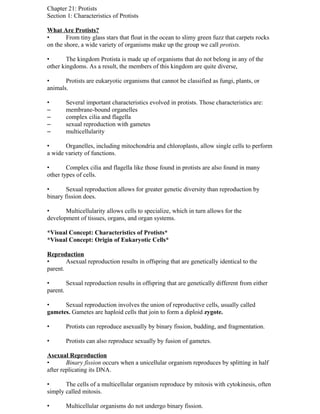
Section 1 Notes-Word Before
- 1. Chapter 21: Protists Section 1: Characteristics of Protists What Are Protists? • From tiny glass stars that float in the ocean to slimy green fuzz that carpets rocks on the shore, a wide variety of organisms make up the group we call protists. • The kingdom Protista is made up of organisms that do not belong in any of the other kingdoms. As a result, the members of this kingdom are quite diverse, • Protists are eukaryotic organisms that cannot be classified as fungi, plants, or animals. • Several important characteristics evolved in protists. Those characteristics are: – membrane-bound organelles – complex cilia and flagella – sexual reproduction with gametes – multicellularity • Organelles, including mitochondria and chloroplasts, allow single cells to perform a wide variety of functions. • Complex cilia and flagella like those found in protists are also found in many other types of cells. • Sexual reproduction allows for greater genetic diversity than reproduction by binary fission does. • Multicellularity allows cells to specialize, which in turn allows for the development of tissues, organs, and organ systems. *Visual Concept: Characteristics of Protists* *Visual Concept: Origin of Eukaryotic Cells* Reproduction • Asexual reproduction results in offspring that are genetically identical to the parent. • Sexual reproduction results in offspring that are genetically different from either parent. • Sexual reproduction involves the union of reproductive cells, usually called gametes. Gametes are haploid cells that join to form a diploid zygote. • Protists can reproduce asexually by binary fission, budding, and fragmentation. • Protists can also reproduce sexually by fusion of gametes. Asexual Reproduction • Binary fission occurs when a unicellular organism reproduces by splitting in half after replicating its DNA. • The cells of a multicellular organism reproduce by mitosis with cytokinesis, often simply called mitosis. • Multicellular organisms do not undergo binary fission.
- 2. Asexual Reproduction #2 • Budding is a form of asexual reproduction in which a part of the parent organism pinches off and forms a new organism. • Budding can occur in unicellular and multicellular organisms. • Budding differs from binary fission in that the offspring is smaller than the parent. Asexual Reproduction #3 • In fragmentation, part of a multicellular organism breaks off and starts a new organism. • Fragmentation differs from budding in that budding is an action that is performed by the organism itself. Fragmentation is the result of an action that is done to an organism. • For example, an accident can result in fragmentation, but not budding. Sexual Reproduction • In many protists, sexual reproduction occurs as a response to environmental stress. • In some protists, the zygote secretes a tough outer coating and becomes a zygospore. • Zygospores can survive freezing, drying, and UV radiation. • In most unicellular protists, a mature organism is haploid. A haploid cell divides by binary fission to produce haploid gametes. • Two gametes fuse to form a diploid zygote and a zygospore. • When environmental conditions improve, meiosis occurs within the zygospore. Haploid cells break out of the zygospore and grow into mature cells. *Visual Concept: Sexual Reproduction in Unicellular Protists* • Many multicellular protists can reproduce both sexually and asexually. • This process, called alternation of generations, consists of multicellular haploid and multicellular diploid phases. • The diploid, spore-producing phase is called the sporophyte generation. • The adult sporophyte has sporangia, reproductive cells that produce haploid spores by meiosis. • The spores grow into multicellular haploid organisms. The haploid, gamete- producing phase is called the gametophyte generation. • The mature gametophyte produces haploid gametes by mitosis. • Two gametes fuse to form a diploid zygote. • The zygote divides to form a multicellular diploid organism. • This step begins the first stage of a new sporophyte generation. *Visual Concept: Reproduction in Ulva*
